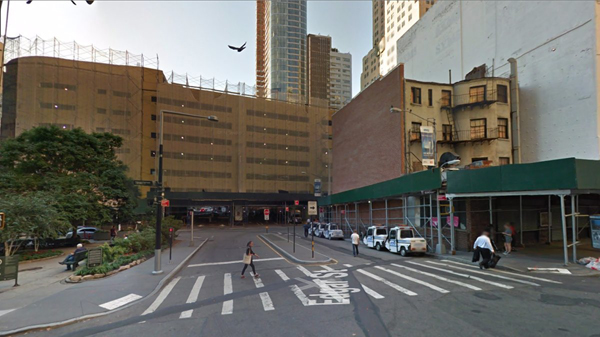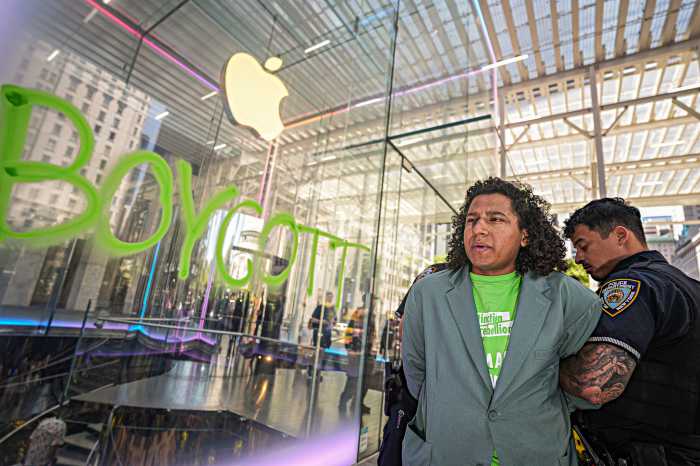
With a new elementary school planned for the site on the right, there’s a growing push to close Edgar St. and make it part of the plaza on the left to give students at the upcoming Trinity Place School more outdoor recreational space.
BY COLIN MIXSON
Members of Community Board 1 are working overtime on a proposal to close down all or part of a tiny, little-used street to provide a safe spot for students of the upcoming Trinity Place School to pile out of buses and evacuate in case of emergencies — not to mention play during recess.
The panel is organizing a working group to formulate a recommendation on the proposal — which was originally floated by the chairwoman of CB1’s Youth and Education Committee, Tricia Joyce — in time for a January meeting of the School Overcrowding Task Force.
Joyce said she came up with the idea after she realized that the current plans for outdoor space at the school were not adequate.
“All they have is this roughly 650-square-foot courtyard. That’s tiny and it’s not adequate for drop-off and pickup for the school,” said Joyce, who joined the working group. “A plan has to be in place by the time this opens.”
Her proposal calls for the permanent closure and repaving of either both lanes of Edgar St. between Greenwhich St. and Trinity Pl., or just the westbound lane and median, leaving the eastbound lane open for traffic.
Edgar St. is only about 25 feet long and exists entirely between Greenwhich St. and Trinity Pl. beside the site of the upcoming school.
Just closing the short street in the morning and afternoon for pickups and drop-offs would not be sufficient, according to Joyce, who said kids also need a safe place to evacuate in the event of a fire drill, or — god forbid — an actual fire.
“This is not an amenity, this is school safety,” said Joyce. “This school needs a plan for fire-drill evacuation and overall school safety.”
Both proponents and critics of the plan agree that traffic in the area is a nightmare, and Trinity Pl. in particular can look like a speedway thanks to traffic whizzing out of the nearby Brooklyn-Battery Tunnel.
But that agreement about traffic will likely fuel division of closing Edgar St., with fans of closing it citing concerns for kids’ safety, and detractors worrying that the closure would cause further gridlock in an already congested area, according to the chairwoman of CB1’s Quality of Life Committee.
“It seems obvious to me that any closures of any streets in our area is detrimental to all of us who live and work there,” said Pat Moore, who lives on nearby Greenwhich St. and also volunteered for the working group. ”At the moment, it doesn’t seem like a workable idea for the surrounding area.”
The proposal is in the earliest stages of planning and volunteers for the working group, even those with serious reservations, expressed a willingness to keep an open mind to the needs of future students, Moore said.
“I’m joining the group to hear why they need this pickup and drop-off space,” she said. “If I disagree with it, I will certainly voice my opinion… If they can prove it will not impact the flow of traffic, I might go ahead with it.”
The Edgar St. proposal was prompted in large part by lessons learned at the Peck Slip School, which suffered numerous planning woes, including inadequate recreation space, with a combined gym and auditorium — called a gymnatorium — that essentially halved the amount of space for athletic and creative activities available to students.
The activity-space shortage at the Peck Slip School led to the closure of a nearby street as a “play street” — an effort that got bogged down by conflicts with a nearby parking garage, and which parents argued should have been dealt with before the school opened.
As a result, local activists are being a bit more proactive in identifying and finding solutions for problems that, in the past, they might have left up to the city, Joyce said.
“I would expect that this is something that should be carefully planned for before the design phase,” Joyce said. “That’s largely completed, and we are casing solutions after the fact, but we’re getting faster.”




































